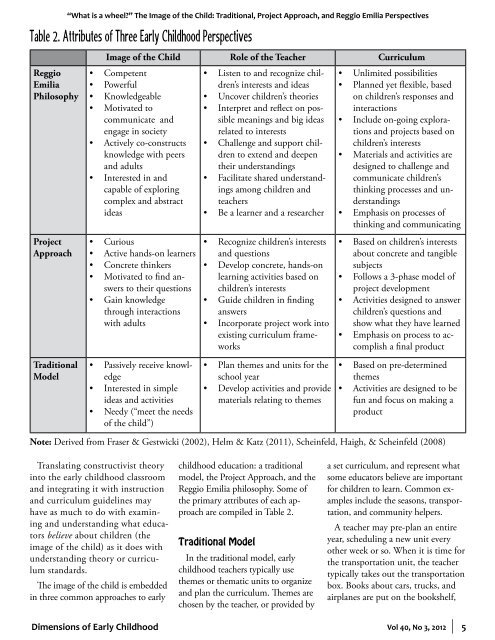Volume 40, Number 3, 2012 Traditional, Project, Reggio ° Family ...
Volume 40, Number 3, 2012 Traditional, Project, Reggio ° Family ...
Volume 40, Number 3, 2012 Traditional, Project, Reggio ° Family ...
Create successful ePaper yourself
Turn your PDF publications into a flip-book with our unique Google optimized e-Paper software.
“What is a wheel?” The Image of the Child: <strong>Traditional</strong>, <strong>Project</strong> Approach, and <strong>Reggio</strong> Emilia Perspectives<br />
Table 2. Attributes of Three Early Childhood Perspectives<br />
Image of the Child Role of the Teacher Curriculum<br />
<strong>Reggio</strong><br />
Emilia<br />
Philosophy<br />
• Competent<br />
• Powerful<br />
• Knowledgeable<br />
• Motivated to<br />
communicate and<br />
engage in society<br />
• Actively co-constructs<br />
knowledge with peers<br />
and adults<br />
• Interested in and<br />
capable of exploring<br />
complex and abstract<br />
ideas<br />
• Listen to and recognize children’s<br />
interests and ideas<br />
• Uncover children’s theories<br />
• Interpret and reflect on possible<br />
meanings and big ideas<br />
related to interests<br />
• Challenge and support children<br />
to extend and deepen<br />
their understandings<br />
• Facilitate shared understandings<br />
among children and<br />
teachers<br />
• Be a learner and a researcher<br />
• Unlimited possibilities<br />
• Planned yet flexible, based<br />
on children’s responses and<br />
interactions<br />
• Include on-going explorations<br />
and projects based on<br />
children’s interests<br />
• Materials and activities are<br />
designed to challenge and<br />
communicate children’s<br />
thinking processes and understandings<br />
• Emphasis on processes of<br />
thinking and communicating<br />
<strong>Project</strong><br />
Approach<br />
• Curious<br />
• Active hands-on learners<br />
• Concrete thinkers<br />
• Motivated to find answers<br />
to their questions<br />
• Gain knowledge<br />
through interactions<br />
with adults<br />
• Recognize children’s interests<br />
and questions<br />
• Develop concrete, hands-on<br />
learning activities based on<br />
children’s interests<br />
• Guide children in finding<br />
answers<br />
• Incorporate project work into<br />
existing curriculum frameworks<br />
• Based on children’s interests<br />
about concrete and tangible<br />
subjects<br />
• Follows a 3-phase model of<br />
project development<br />
• Activities designed to answer<br />
children’s questions and<br />
show what they have learned<br />
• Emphasis on process to accomplish<br />
a final product<br />
<strong>Traditional</strong><br />
Model<br />
• Passively receive knowledge<br />
• Interested in simple<br />
ideas and activities<br />
• Needy (“meet the needs<br />
of the child”)<br />
• Plan themes and units for the<br />
school year<br />
• Develop activities and provide<br />
materials relating to themes<br />
• Based on pre-determined<br />
themes<br />
• Activities are designed to be<br />
fun and focus on making a<br />
product<br />
Note: Derived from Fraser & Gestwicki (2002), Helm & Katz (2011), Scheinfeld, Haigh, & Scheinfeld (2008)<br />
Translating constructivist theory<br />
into the early childhood classroom<br />
and integrating it with instruction<br />
and curriculum guidelines may<br />
have as much to do with examining<br />
and understanding what educators<br />
believe about children (the<br />
image of the child) as it does with<br />
understanding theory or curriculum<br />
standards.<br />
The image of the child is embedded<br />
in three common approaches to early<br />
childhood education: a traditional<br />
model, the <strong>Project</strong> Approach, and the<br />
<strong>Reggio</strong> Emilia philosophy. Some of<br />
the primary attributes of each approach<br />
are compiled in Table 2.<br />
<strong>Traditional</strong> Model<br />
In the traditional model, early<br />
childhood teachers typically use<br />
themes or thematic units to organize<br />
and plan the curriculum. Themes are<br />
chosen by the teacher, or provided by<br />
a set curriculum, and represent what<br />
some educators believe are important<br />
for children to learn. Common examples<br />
include the seasons, transportation,<br />
and community helpers.<br />
A teacher may pre-plan an entire<br />
year, scheduling a new unit every<br />
other week or so. When it is time for<br />
the transportation unit, the teacher<br />
typically takes out the transportation<br />
box. Books about cars, trucks, and<br />
airplanes are put on the bookshelf,<br />
Dimensions of Early Childhood Vol <strong>40</strong>, No 3, <strong>2012</strong> 5
















